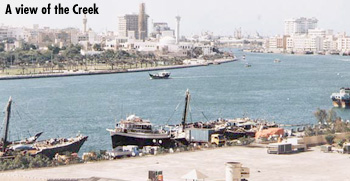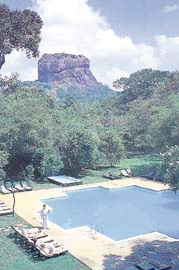Ports of Call
Advancing to the timeless rhythm of sea trade
The steward greeted me by name and I replied immediately
as I remembered his name. After all, he had served me only a week before.
Then I did a double take. I had last seen him in Colombo and there he was
serving me in Dubai.
For Sri Lankans, it is no longer extraordinary to go to Dubai either
for work or on holiday. Sri Lankans are in key posts everywhere there,
not just in the hospitality industry. What is extraordinary is the phenomenal
growth of Dubai itself.
From the balcony of my hotel room I had a view of the Creek, a natural
sea-water inlet that cuts through the centre of the city. Rusty freighters,
and dhows with their distinctive high-stern design, manoeuvre at a stately
pace along its length. While high-rise buildings testify to Dubai's progressive
development, its foundations lie in the timeless rhythm of sea trading.
 The
Creek provides an insight into the heart of Dubai. According to one brochure:
"Visitors will be captivated by the colour and bustle of the loading
and unloading of dhows which still ply ancient trade routes to places as
distant as India and East Africa." The
Creek provides an insight into the heart of Dubai. According to one brochure:
"Visitors will be captivated by the colour and bustle of the loading
and unloading of dhows which still ply ancient trade routes to places as
distant as India and East Africa."
If you know Dubai only from its airport and its souk of duty free shops,
you will be unprepared for the diversity that is Dubai. The city is predominantly
modern, its skyline changing constantly as new glass and concrete constructions
compete with each other to offer the latest "state-of-the-art"
this and that.
It's sobering to think that just 30 years ago, Dubai wasn't worth writing
home about. Go back a further 125 years to the 1830s and there was nothing
there at all. At that time, a small fishing village at the mouth of the
Creek was settled by a branch of the Bani Yas tribe, led by the Maktoum
family who still rule the Emirate today.
Nomadic Bedouin roamed with their camel herds in the blazing heat of
the desert. Where now air-conditioned limousines purr along sweeping highways,
farmers tended date palms, and sheep and goat herds scratched a living
wherever a trace of water could be found.
Pearls became a major factor in Dubai's rise as a trading centre. By
1890 it became one of the principal ports on the Gulf coast, attracting
traders from Iran and India. It was known as "The City of Merchants."
The cream on the cake was black. Oil, discovered in the 1960s, added
a special delight to Dubai's development. The income from oil enabled intensive
government investment with Dubai becoming the main commercial centre of
the United Arab Emirates. Trading and business ties extended beyond the
Middle East to all corners of the world.
Dubai believes itself to be a 21st Century city, and it is probably
right. Just in case you miss the point, drive for 25 minutes from the airport
to Dubai's shore. There a futuristic resort has opened that challenges
credulity.
It is a 26-storey hotel with 600 bedrooms, built to a design that reflects
Dubai's seafaring heritage. The massive structure is said to represent
a breaking wave. To see it for the first time is to wonder what all that
aluminium and glass curving skyward is doing in the desert.
In the answer lies the future of tourism, not just in Dubai but in any
resort area that wants to lead the way. The Jumeirah Beach Hotel is so
stunning that everyone talks about it. And everyone wants to visit it and
stay there and even work there.
Architecturally, it is a landmark conceived, in the words of one of
its promoters: "as a unique project that would break the mould in
terms of design and architecture". The modern facade of the hotel
is achieved through the primary use of reflective glass and aluminium.
The interior theme draws upon the four elements of nature: Earth, Air,
Fire and Water.
This is done through a colour scheme that divides the hotel floors into
four different levels: blues and greens for Water, browns and reds for
Earth, blues and white for Air and reds and yellows depicting the Fire
of a vibrant sun. The 26 floors are linked by a 270 feet high sculpture
which clings to the wall of the atrium. It represents a satellite view
of the earth with stars and the moon in orbit and with UAE at its centre.
This conceit is acceptable when you consider the hotel's facilities
which include no less than 18 different theme restaurants and four swimming
pools. It is a hotel of the future because even the most jaded of jet setters
are sure to be stirred by the excitement of staying there. Traditionalists
might consider it vulgar; I found it vibrant.
I was led to visit the hotel to see some of the many Sri Lankans who
work there. If a steward or roomboy has disappeared from your favourite
Colombo five-star hotel, you'll probably find him at Jumeirah Beach Hotel,
or at one of its competitors.
The thrill I experienced at this vision of the future was put into perspective
when I left Dubai. There, in the business class lounge at the airport,
sitting serenely among young executives carrying briefcases, was an old
Arab. His face was lined and expressionless, burnished by hours gazing
at the desert sun. His partner sat on his wrist, eyes hooded.
It was a falcon, alert and proud. Falconry, a unique partnership between
man and bird, is an ancient pastime still practised in Dubai. Seeing the
falcon and his veteran owner in the airport reminded me that even Dubai's
enviable future would be nowhere without its traditional past.
Rustic elegance
 Few
hotels can boast of being built on World Heritage sites but Sigiriya Village
set amidst 26 acres of lush garden can do so. Built in 1975, the Sigiriya
Village has a unique vantage view of the majestic Sigiriya rock fortress. Few
hotels can boast of being built on World Heritage sites but Sigiriya Village
set amidst 26 acres of lush garden can do so. Built in 1975, the Sigiriya
Village has a unique vantage view of the majestic Sigiriya rock fortress.
In an age where many hotels sit cheek by jowl with others, Sigiriya
Village in the heart of the Cultural Triangle prides itself in its relaxed
ambiance. Here visitors can rediscover the wonders of nature. From the
entrance, where one drives from a dusty roadway through a canopy of leaf
green and is greeted by the sound of birds, one is enveloped by nature.
The rustic theme pervades the hotel with its 120 cottage style rooms
elegantly decorated, yet affording again that closeness with nature. All
rooms have their own private verandah where one can lounge at leisure and
take in the sight of frolicking squirrels and inquisitive monkeys.
For those with an adventurous streak, there's plenty to do beside swimming
in the hotel's beautifully located pool with the Sigiriya Rock in the backdrop.
Jungle treks are organised by the hotel, along with excursions to the Wasgamuwa
park, the Minneriya and Kalawewa tanks, and the Pidurangana Viharaya .
The hotel also has plenty of entertainment for kids, cycling, elephant
rides and indoor games.
Despite its rustic setting, the hotel is not short of entertainment,
with calypso bands, cultural shows and magic shows being arranged daily,
with a DJ coming in on weekends.
The hotel is well-known for its traditional Sri Lankan cuisine. A farm
located within the hotel premises provides an ample supply of fresh fruits
and vegetables.
And if you're in the mood for some herbal treatment, the Ayurvedic Centre
offers a range of treatments. A new feature is the Sigiriya Village Gift
Voucher which offers many benefits and discounts. These vouchers are available
at the hotel's sales and reservations office at Colombo 9.
Also available now is the Thotulagala plantation bungalow in Haputale,
a new acquisition to the group.
|





 The
Creek provides an insight into the heart of Dubai. According to one brochure:
"Visitors will be captivated by the colour and bustle of the loading
and unloading of dhows which still ply ancient trade routes to places as
distant as India and East Africa."
The
Creek provides an insight into the heart of Dubai. According to one brochure:
"Visitors will be captivated by the colour and bustle of the loading
and unloading of dhows which still ply ancient trade routes to places as
distant as India and East Africa."  Few
hotels can boast of being built on World Heritage sites but Sigiriya Village
set amidst 26 acres of lush garden can do so. Built in 1975, the Sigiriya
Village has a unique vantage view of the majestic Sigiriya rock fortress.
Few
hotels can boast of being built on World Heritage sites but Sigiriya Village
set amidst 26 acres of lush garden can do so. Built in 1975, the Sigiriya
Village has a unique vantage view of the majestic Sigiriya rock fortress.